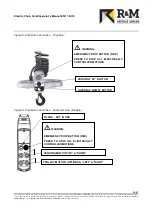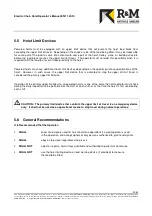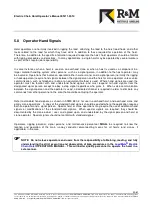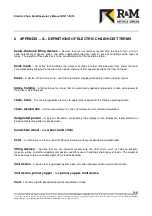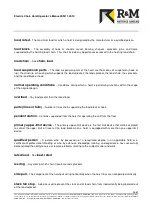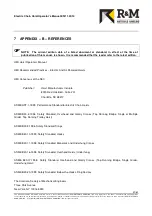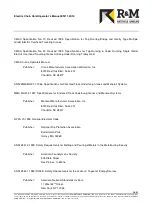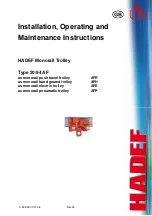
Electric Chain Hoist Operator’s Manual/EN/11.30.10
33/41
This document and the information contained herein, is the exclusive property of R&M MATERIALS HANDLING, INC. and represents a non-public, confidential and proprietary trade
secret that may not be reproduced, disclosed to third parties, altered or otherwise employed in any manner whatsoever without the express written consent of R&M MATERIALS
HANDLING, INC. . Copyright © (2010) R&M MATERIALS HANDLING, INC. . All rights reserved.
5.8 Operator Hand Signals
Hoist operators are normally involved in rigging the load, attaching the load to the hoist load hook, and other
tasks related to the load for which they have skills in addition to those required for operation of the hoist.
Therefore, in addition to the specific information required to operate the hoist, hoist operators should be familiar
with rigging procedures and practices. In many applications, a single hoist may be operated by several workers
as part of their regular job responsibility.
In some instances, when a hoist is used on an overhead crane or when a hoist is used as a component in a
larger material handling system, other persons, such as a signal person, in addition to the hoist operator, may
be involved. Operations that involve an operator (either hoist or crane) and a signal person (normally the rigging
or hookup person) require hand signals between the signal person and the hoist or crane operator unless voice
communication, such as telephone, radio, or an equivalent method, is used. Where hand signals are used, the
operator must be familiar with and understand hand signals, and must respond to hand signals from the
designated signal person except to obey a stop signal regardless who gives it. When voice communication
between the signal person and the operator is used, a dedicated channel is required in order to eliminate any
commands from other personnel in the area that could be confusing the operator.
Refer to standard hand signals, as shown in ASME B30.2, for use in overhead hoist, and overhead crane and
gantry crane operations. A copy of the standard hand signals should be posted where the application requires
both an operator and a signal person. Special hoist or crane operations may require the use of additional hand
signals or modifications of the standard hand signals. When special signals are required, they should be
documented by the crane owner / user, and agreed upon, and understood, by the signal person and hoist or
crane operator. Special signals should not conflict with standard signals.
Operators, rigging personal, signal persons, and maintenance personnel
SHALL
be required to know the
location and operation of the main runway conductor disconnecting means for all hoists (and cranes, if
applicable) in the area.
NOTE: Do not release operators and users from the responsibility of obtaining, reading, and fully
understanding the strict execution and observation of ALL procedures in the
LoadMate® Electric
Chain Hoist
OPERATOR’S MANUAL. This will better qualify personnel to operate the hoist in a
safe manner.




